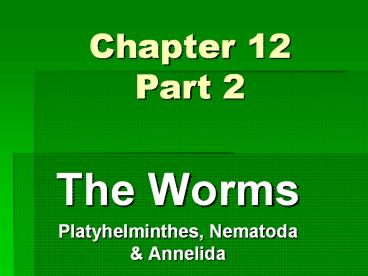Chapter 12 Part 2 - PowerPoint PPT Presentation
Title:
Chapter 12 Part 2
Description:
Chapter 12 Part 2 The Worms Platyhelminthes, Nematoda & Annelida Phylum: Platyhelminthes Examples: Flatworms, Planaria sp., tapeworms and blood flukes Acoelomate ... – PowerPoint PPT presentation
Number of Views:144
Avg rating:3.0/5.0
Title: Chapter 12 Part 2
1
Chapter 12 Part 2
- The Worms
- Platyhelminthes, Nematoda Annelida
2
Phylum Platyhelminthes
- Examples Flatworms, Planaria sp., tapeworms and
blood flukes - Acoelomate, Invertebrate, Simplest critter w/
bilateral symmetry - Simplest critter w/ cephalazation (distinct
head region) (anterior) and tail (posterior)
regions - Most are aquatic
- Free living parasitic lifestyles
28 foot long tapeworm!
3
Flatworms
- Free Living Example - Planarians
- Dorsoventrally flattened
- Able to regenerate
- Circulatory Respiratory diffusion w/
environment - Digestive system - Incomplete w/ mouth pharynx
Gastrovascular cavity (GVC) which consists of
branching intestine - Excretory System flame cells excretory pores
- Nervous System - Includes anterior cerebral
ganglia brain, longitudinal nerve cords, and
some lateral nerves, light sensitive eye spots - Muscular System under epidermis,
- layer of circular longitudinal muscles
- Reproduction
- Asexual fission regeneration
- Sexual hermaphroditic produce both eggs
- sperm
AKA GVC
4
Flatworms
- Parasitic Examples Tapeworms Flukes
- Complex multi-host life cycles
- Can be over 30 feet long!
- Eggs/larvae found in uncooked fish meats
- No digestive system absorb nutrients directly
from host intestines - Structure
- Scolex - anterior head region w/ hooks suckers
used to attach to the host intestinal wall - Proglottids - Extending from the neck is a series
of proglottids contain the sex organs each
mature proglottid release thousands of fertilized
eggs into the hosts digestive tract for
elimination.
5
Phylum Nematoda
- Roundworms Ascaris sp., hookworms, pinworms
- Pseudocoelomates,
- Bilateral symmetry
- Free living and parasitic Aquatic- marine and
freshwater and terrestrial - May be the most abundant animals on earth.
- A bucket of soil can contain gt 1 million
roundworms!! - Simplest invertebrate with complete digestive
system ( 2 openings) mouth and anus present - Lack circulatory respiratory systems
- Primitive excretory cells excrete through pores
- Muscular system w/ only longitudinal muscles no
circular muscles cause worm to thrash back
forth. Require something to push against to move
forward. - Nervous system has main ventral nerve cord
- Reproduce sexually, first animals we have
studied w/ separate male female
animals.
6
Phylum Annelida
- Segmented worms- earthworms, leeches, bloodworms,
sandworms, polycheate worms - Bilateral symmetry
- Coelomate first animal weve studied w/ a true
coelum - Invertbrate, aquatic (freshwater marine)
terrestrial - From lt 1mm to over 10 feet long
- Free living parisitic
- Medical use of leeches anticoagulant secreted
after sucker attaches stops blood from clotting.
7
Annelids Segmented Worms
- Digestion Complete system Mouth, pharynx,
esophagus, crop, gizzard, stomach, intestine,
anus (ding-a-ling!) - Respiration Aquatic annelids typically breath
through gills, whereas terrestrial annelids
diffusion O2 and CO2 thru the skin - Internal Transport The Circulation First
critter w/ true circulatory system. Closed
circulation w/ dorsal ventral blood vessels
connected at each segment w/ smaller vessels
called ring vessels. Has 5 pairs of enlarged
ring vessels called Aortic Arches which act as
hearts to pump the blood. - Excretory system Nitrogenous wastes from
cellular activities excreted thru use of
nephridia, (small tubular structures located in
each metamere. - Nervous system is well developed w/ organized
dorsal brain extending ventrally to a ventral
nerve cord which connects small nerves from each
segment (metamere) - Movement muscles in the annelid are of two
types longitudinal and circular - Reproduction most reproduce sexually, some w/
separate sexes and some species have individuals
w/ both male and female organs in the same animal
hermaphroditic.
8
External Anatomy
- 1. Mouth ingest food and materials into
digestive system - 2. Anus Undigested food and wastes leave the
body - 3. Metamere Segments of the earthworm
- 4. Setae bristles found on ventral surface
- 5. Clitellum secretes mucus and egg sacs
Polycheate Worm
Distinct dorsal (dark colored) ventral (light
colored) areas
mouth
9
Internal Structures and Function
- 1. Mouth (entrance) 11. 5 pairs)Aortic
Arches (hearts) - 2. Pharynx (grabs food pulls in) 12.
Cerebral Ganglia (brain) - 3. Esophagus (passage way) 13. Dorsal
blood vessel (vein) - 4. Crop (stores food)
14. Ventral Blood vessel (artery) - 5. Gizzard (grinds) 15. Septa snare
drum tissue - 6. Stomach (digests) between metameres
- 7. Seminal Vesicles
- 8. Intestine (digests)
- 9. Anus (eliminates)
- 10. Ventral Nerve
- Cord
10
- More worm diagrams
11
All done w/ this worm stuff































